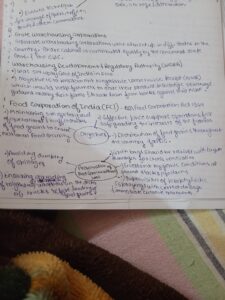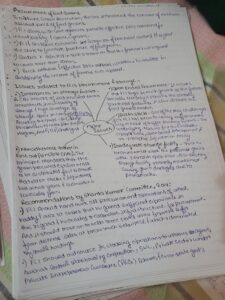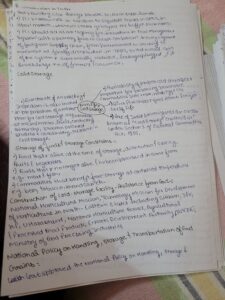Examine how well the Public Distribution System (PDS) can guarantee food security and give the economically disadvantaged segments of the population reasonably priced access to necessities, especially in light of the shift to cash-based transfer programs and the application of ...
The Role of the Public Distribution System (PDS) in India's Food and Agricultural Policies 1. Introduction The Public Distribution System (PDS) is a critical component of India's food and agricultural policies, aimed at ensuring food security for the economically disadvantaged. This system providesRead more
The Role of the Public Distribution System (PDS) in India’s Food and Agricultural Policies
1. Introduction
The Public Distribution System (PDS) is a critical component of India’s food and agricultural policies, aimed at ensuring food security for the economically disadvantaged. This system provides subsidized food grains to the poor and is integral to the government’s broader objectives of promoting sustainable agriculture, improving farmers’ incomes, and ensuring inclusive development. This analysis will explore the role of the PDS within this larger context and evaluate its alignment with the government’s policy goals.
2. Role of the PDS in Food and Agricultural Policies
Ensuring Food Security:
The primary role of the PDS is to ensure food security by distributing essential commodities at subsidized rates to the poor. This is crucial in addressing hunger and malnutrition, especially in vulnerable populations.
Recent Example: During the COVID-19 pandemic, the Indian government expanded the PDS to provide free food grains to an additional 80 crore people under the Pradhan Mantri Garib Kalyan Ann Yojana (PMGKAY), reflecting the system’s role in addressing emergency food security needs.
Stabilizing Prices:
By procuring food grains from farmers and distributing them through the PDS, the government helps stabilize market prices and prevent extreme fluctuations, which can impact both consumers and farmers.
Recent Example: The Minimum Support Price (MSP) mechanism, coupled with PDS operations, has been used to stabilize rice and wheat prices in states like Punjab and Haryana, ensuring price stability in both procurement and consumer markets.
3. Alignment with Government Objectives
Promoting Sustainable Agriculture:
While the PDS itself does not directly address agricultural sustainability, the procurement practices associated with it can influence farming practices. For instance, the MSP encourages farmers to adopt certain crops, which can impact sustainable farming practices.
Recent Example: The introduction of Paddy-to-Millet schemes in states like Jharkhand is part of efforts to encourage sustainable crops. However, the PDS still largely relies on staples like rice and wheat, which can sometimes limit the focus on diverse and sustainable agricultural practices.
Improving Farmers’ Incomes:
The PDS’s procurement system helps ensure a stable income for farmers by guaranteeing the purchase of their produce at predetermined prices. This supports farmers’ incomes and provides them with financial security.
Recent Example: The Pradhan Mantri Annadata Aay Sanrakshan Abhiyan (PM-AASHA) scheme, aimed at enhancing farmers’ income, works in conjunction with the PDS by ensuring better price realization for their produce through MSP and procurement mechanisms.
Ensuring Inclusive Development:
The PDS is designed to be inclusive by targeting subsidized food grains to the economically weaker sections of society. This aligns with broader goals of social equity and poverty alleviation.
Recent Example: The National Food Security Act (NFSA) of 2013 aims to cover 75% of the rural population and 50% of the urban population, thereby ensuring that food security measures reach a large segment of the population, including the poor and vulnerable.
4. Challenges and Areas for Improvement
Limited Focus on Sustainable Agriculture:
The PDS primarily focuses on staple grains, potentially neglecting the promotion of diverse and sustainable agricultural practices. A shift towards supporting a wider range of crops and sustainable practices could enhance alignment with broader agricultural goals.
Recent Example: The government’s focus on cereals has overshadowed the promotion of pulses and oilseeds, which are also critical for nutritional diversity and sustainable agriculture.
Inefficiencies in Distribution:
Issues such as leakages, diversion, and inefficiencies in the PDS distribution network can undermine its effectiveness. These challenges need to be addressed to enhance the overall impact of the PDS on food security and inclusive development.
Recent Example: In Uttar Pradesh, efforts to digitize and streamline the PDS have been implemented to address inefficiencies and improve transparency, but challenges remain in ensuring effective distribution.
Need for Better Integration with Other Policies:
While the PDS plays a crucial role, better integration with agricultural and welfare policies could enhance its effectiveness. Aligning PDS operations with schemes promoting organic farming, crop diversification, and rural development can provide a more comprehensive approach to food and agricultural policy.
Recent Example: The National Mission on Sustainable Agriculture (NMSA) aims to promote sustainable practices, but its integration with PDS could be strengthened to support holistic agricultural development.
5. Conclusion
The Public Distribution System (PDS) is a vital component of India’s food and agricultural policies, contributing significantly to food security, price stabilization, and poverty alleviation. While it supports the government’s objectives of improving farmers’ incomes and ensuring inclusive development, there is room for improvement in aligning PDS operations with sustainable agricultural practices and broader policy goals. Addressing challenges related to inefficiencies and integrating PDS with other agricultural and welfare schemes can enhance its effectiveness and impact on both food security and agricultural development.
See less



Examining the Effectiveness of the Public Distribution System (PDS) in Ensuring Food Security 1. Introduction The Public Distribution System (PDS) is a key government initiative aimed at ensuring food security and providing subsidized food to economically disadvantaged segments of the population inRead more
Examining the Effectiveness of the Public Distribution System (PDS) in Ensuring Food Security
1. Introduction
The Public Distribution System (PDS) is a key government initiative aimed at ensuring food security and providing subsidized food to economically disadvantaged segments of the population in India. With recent shifts towards cash-based transfer programs and technological interventions, evaluating the effectiveness of the PDS in achieving its goals is crucial. This analysis explores how well the PDS performs in guaranteeing food security and access to necessities, especially in the context of evolving strategies.
2. Effectiveness of the PDS in Ensuring Food Security
Subsidized Food Supply: The PDS provides essential food items such as rice, wheat, and sugar at subsidized rates to eligible households. This system is designed to address food insecurity and provide relief to low-income families.
Recent Example: During the COVID-19 pandemic, the government expanded the PDS to include additional beneficiaries and provided free food grains to nearly 800 million people through the Pradhan Mantri Garib Kalyan Anna Yojana (PMGKAY), demonstrating the system’s role in addressing acute food insecurity.
Coverage and Reach: The PDS aims to cover a significant portion of the population, including those below the poverty line (BPL) and priority households. The effectiveness of this coverage in reaching intended beneficiaries is a key measure of the system’s success.
Recent Example: The NFSA (National Food Security Act) 2013 mandates coverage of up to 75% of the rural population and 50% of the urban population, with recent reforms aiming to improve coverage and inclusion.
3. Challenges and Limitations of the PDS
Leakages and Diversion: One of the major challenges facing the PDS is the issue of leakages and diversion of subsidized food grains. Corruption and inefficiencies in the supply chain can result in food not reaching the intended beneficiaries.
Recent Example: The 2018 CAG report highlighted issues of mismanagement and diversion of food grains in states like Uttar Pradesh and Bihar, emphasizing the need for stronger oversight and reforms.
Inefficiencies in Distribution: Delays and inefficiencies in the distribution process can hinder the timely delivery of food to beneficiaries, affecting the system’s effectiveness in ensuring food security.
Recent Example: During the COVID-19 lockdowns, reports emerged of delays in distribution and challenges faced by beneficiaries in accessing food through PDS outlets.
4. Shift to Cash-Based Transfer Programs
Advantages of Cash Transfers: Cash-based transfer programs, such as direct benefit transfers (DBT), offer flexibility to beneficiaries by allowing them to purchase food and other necessities from local markets. This approach can potentially reduce leakages and increase the efficiency of assistance.
Recent Example: The PM-KISAN scheme provides direct cash transfers to farmers, which has been praised for its efficiency and impact on rural incomes. However, the broader application of cash transfers for food security remains limited.
Integration with PDS: Combining cash transfers with the existing PDS system can provide a hybrid approach that leverages the strengths of both systems. Cash transfers can complement in-kind assistance to address gaps in coverage and distribution.
Recent Example: The One Nation One Ration Card (ONORC) scheme aims to integrate PDS with cash transfer schemes to provide a more comprehensive solution for food security across states.
5. Technological Interventions in the PDS
Technology for Transparency: Technological interventions, such as the use of biometric authentication and digital records, can enhance transparency and reduce leakages in the PDS system. These tools help ensure that food reaches the intended beneficiaries.
Recent Example: The Aadhaar-based biometric authentication system has been implemented in several states to improve beneficiary identification and reduce fraud.
E-Governance and Automation: The use of e-governance tools and automation in the PDS can streamline operations, improve efficiency, and reduce manual errors. Digital platforms can facilitate better management and monitoring of the distribution process.
Recent Example: The ePDS (Electronic Public Distribution System) platform in states like Haryana and Punjab uses technology to manage the supply chain and track distribution more effectively.
6. Balancing PDS and Emerging Strategies
Integration of Cash and In-Kind Assistance: Balancing cash-based transfers with the traditional PDS system requires careful consideration of local contexts and needs. Combining both approaches can enhance flexibility and coverage.
Recent Example: The Antyodaya Anna Yojana (AAY) program provides additional food rations to the most disadvantaged, illustrating a targeted approach that complements broader PDS efforts.
Addressing Systemic Issues: Ongoing reforms and improvements in the PDS, such as better monitoring mechanisms, increased accountability, and improved logistics, are essential to address systemic challenges and enhance the system’s effectiveness.
Recent Example: The National Food Security Mission (NFSM) focuses on improving food production and distribution systems, including efforts to address issues related to MSP and procurement.
7. Conclusion
The Public Distribution System (PDS) plays a critical role in ensuring food security and providing access to subsidized food for economically disadvantaged populations. While the system has been effective in many areas, challenges such as leakages, inefficiencies, and coverage issues persist. The shift towards cash-based transfer programs and the application of technological interventions offer opportunities to enhance the effectiveness of the PDS. By integrating cash transfers, leveraging technology, and addressing systemic issues, the government can improve the PDS and better meet the needs of the population, ensuring food security and reasonable access to necessities.
See less